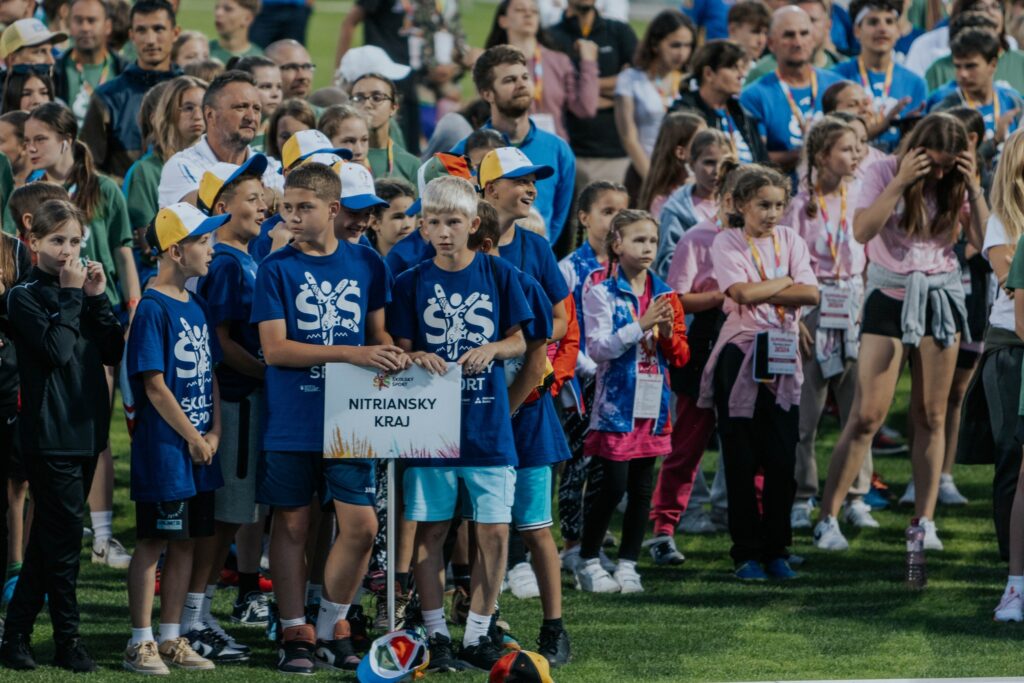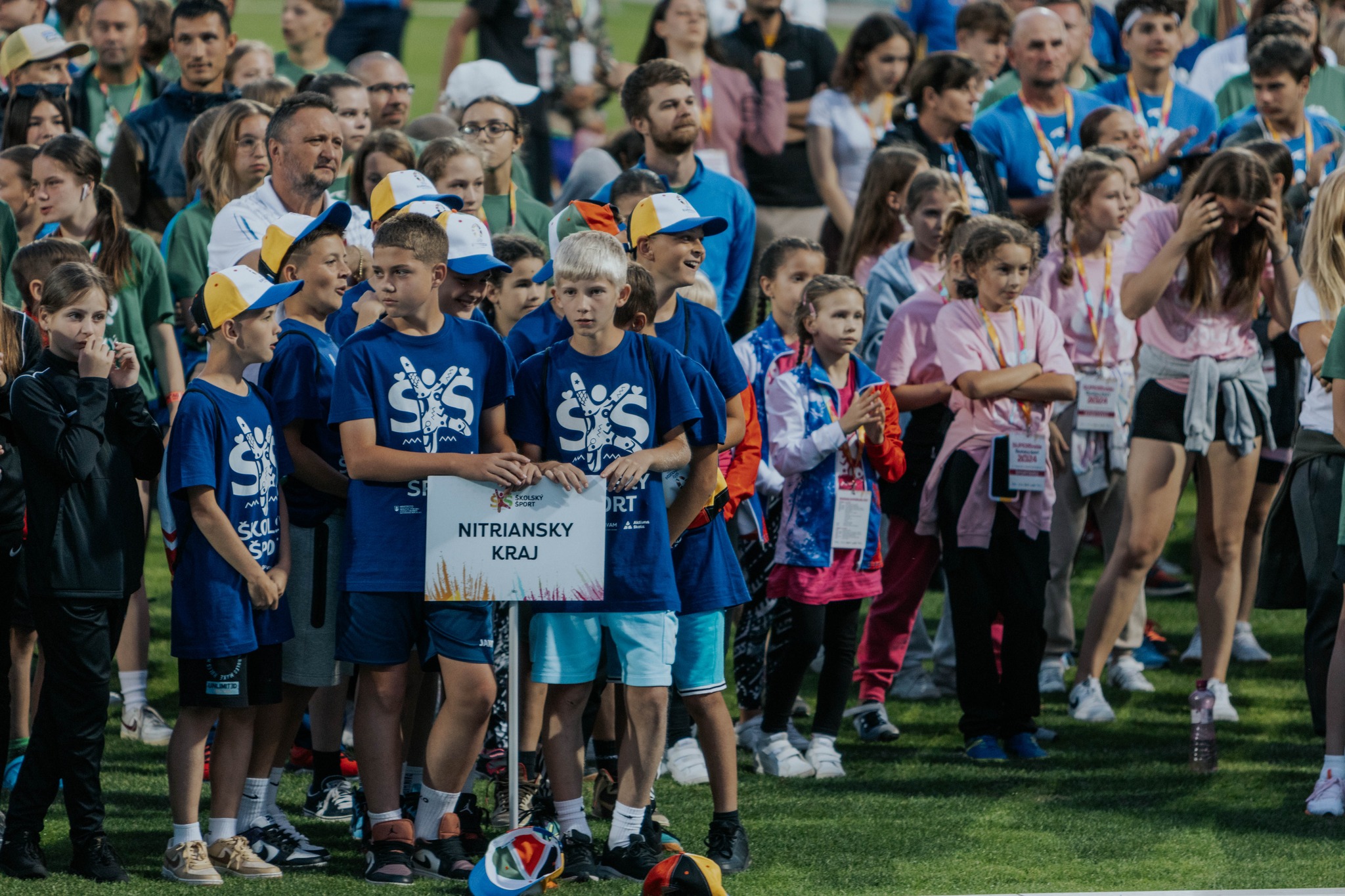SCHOOL SPORT
An experience is more valuable than gold when the experience itself is greater than the victory.
For the third time this year, the x-bionic® sphere resort welcomed the best sportsmen and sportswomen from primary and secondary schools from every corner of Slovakia as part of the SUPERfinal of school sport. Two exciting days of sport, fun and adventure awaited the students. We talked to Pavol Smutny from the Health and Physical Activities Department of the Ministry of Education and Sports of the Slovak Republic about what it is like to organise the biggest school sports festival with 1300 competitors.
Why should we care about students to move more? Don’t children naturally move a lot?
Maybe at nursery age they do, but that changes when they sit down at school. We all naturally move less than our ancestors because today’s times provide us with opportunities to not have to move so much. According to our statistics, today’s schoolchildren move alarmingly little, an average of just 26 minutes a day. This is not even half the daily time recommended by the WHO. But it all adds up later in life, especially in the form of health problems. Increasingly, there is increased talk about obesity and its associated diseases. Children are not yet aware of the consequences, so it is our responsibility to instil exercise habits in them as early as possible. We know that if they get used to moving in childhood, they are more likely to keep moving into adulthood.
But it’s not just about physical health, right?
According to several studies, movement is closely related to the ability to learn and other cognitive functions of the human brain. Countries that have integrated movement into the curriculum have achieved the best results in student tests, where Slovakia has failed. Many teachers in our schools still do not understand that if they want better results from their students in written tests, they should allow them to run around outside instead of suffocating them with more knowledge. Mental health is inseparably linked to movement. Today’s children are under tremendous stress and pressure, and movement can serve as a means by which they can bring this out of themselves.
What proposals is the Ministry coming up with to get students moving in schools?
Students currently spend 80% of their time in school, and that is bad. With the Active School Project, we are trying to change this at different levels, to bring interesting changes to the teaching process that could help activate students. The aim is to integrate movement into the pupils‘ daily routine in a way that is enjoyable and natural for them.
For example, how can this be done?
For example, by coming to school in the morning on foot, on a bike or on a scooter. Enable them to learn not just sitting down, but also in motion. So that they can interrupt class with a movement break or have longer breaks and spend them moving. They could use different activating elements in the school corridors during breaks. Schools could provide different sports courses for students: swimming, cycling, skiing, etc. Healthy eating is also part of the Active School project. We are trying to look at what schools cook, how they communicate the issue of healthy eating to students… These are individual pieces of a big jigsaw of changes, part of the curriculum reform on exercise that we as a ministry want to implement in as many schools as possible. Schools have the opportunity to self-assess themselves within the app we have created and see where they have reserves.
One of the tools to get children moving is school competitions. Why did you decide to organise a SUPERfinal?
Schools have always had competitions in different sports disciplines. However, there was a lack of a culminating event that, besides competing and winning, would also add value to the children in the form of an intense experience, because it is the experience that is the driving force for a person of any age. The aim of the event is not to fight for medals, but to build a positive relationship between children and movement, to deepen teamwork, socialisation and fun. The desire to win. The desire to win in the case of school competitions is not the main reason.
Did you consider different locations when choosing the venue for the event?
The SUPERfinal was originally going to be a travelling event and always take place in a different major city, as travelling from eastern Slovakia to the west is logistically difficult for many students and teachers. However, when we mapped out the possibilities across Slovakia, we came across the problem that it is not possible to accommodate over a thousand pupils and their accompaniment in one location and to compete in the same place. And if we were to split them up into hotels and have the competitions in different locations – in campuses and gyms – it would be logistically unmanageable and untenable. Consider that we had 1,300 competitors here last year. Add to that the spectators. At one point there could have been 3000 people in the x-bionic® sphere, including those who came to watch from nearby Samorin schools. That’s a huge mass.
The decision for the National Olympic Centre x-bionic® sphere was therefore quite simple…
We mapped several Slovak cities, but apart from the x-bionic® sphere resort, we could not find any other similar complex in Slovakia where we could accommodate, cater, entertain and uncompete so many children in one place. Safety was also an important factor – here they are in an enclosed area, they walk barefoot from the hotel straight to the sports field. Teachers don’t have to be alert if they lose sight of the students for a while. The SUPERfinal is primarily about the experience, we wanted the environment in which it takes place to enhance the experience. The fact that it is a top Olympic training centre with professional equipment and sports facilities, where elite athletes go, is therefore the icing on the cake.
Was it a challenge to organise such a mega event?
It’s logistically challenging, and not just because of the high number of kids, but also because of the competitions and the accompanying activities. The individual competitions are provided by the sports federations, they take place at the highest level with rules, professional referees and everything that goes with it. Children are given the opportunity to experience the world of professional sport, something many would never get to do. The event kicks off with an opening ceremony with live music, with a night run later on the first evening. In addition to the competitions, we create a rich accompanying programme for competitors and non-competitors alike. Last year there were 20 different sports and experience providers in the large FUN zone in the parking zone, so those who were not currently competing could fill their time with other interesting sports programmes. We try to do it in a way that both competitors and spectators can enjoy the experience. The organisers from the x-bionic® sphere have been incredibly supportive in this.
What disciplines do the pupils compete in at the SUPERfinals?
We try to make them different from the competitions that are normally done at the level of sports associations. The idea is to give a wider range of children the opportunity to get involved, including those who are not explicitly athletes but are part of a team. All competitions are virtually team-based, with either individuals tallying up points or competing in teams of several.
What has been the reaction of the children to the fact that they will be competing at the Olympic Training Centre, where the best athletes go?
It’s hard to describe it in words, you have to experience it. There were many reactions and many were very moving. From the various social media posts to the enthusiastic sharing with each other about what they experienced here. Children came from all over Slovakia, even children from marginalized groups who had never been to a place like this before, and their teachers described to us how they screamed in surprise as soon as the bus passed through the gates of the complex. They were absolutely thrilled at the idea of spending two days there, sleeping in a hotel and playing sports on top-class sports fields. We expressly wanted the students to stay overnight and spend two days here, even though they are only competing for one day, so that it would have the aforementioned socialising effect, which cannot be achieved in any other way. It is all about strengthening team spirit.
Does it work like a domino effect? Will the competitors, full of experience, return to the school and enthusiastically describe their experiences and maybe motivate others to try it next year too…?
We know that 40% – 50% of SUPERfinal participants are children who are not members of sports clubs. For them, being at a SUPERfinal means immediate contact with the world of professional sport. We also invite a lot of sports stars, last year for example the whole football team came. The children met and took photos with Marek Hamšík, for example. We know that the powerful experience will not only make them want to come back, but they will also pass on their positive experience to their classmates when they return to school in their region.
Can we expect any innovations in the accompanying programme or disciplines this year?
The competitions that the students have competed in all year remain, but this year for the first time we will have two dance competitions – modern dance and an open hip hop competition in the FUN Zone in the form of a battle. We’re trying to bring in the not-so-standard sports as well. As the Ministry of Education, under the Modules Project, we work with 18 sports organisations of sectors like karate, judo, golf, etc. during the year. Normally these sports are not done in physical education classes. We have invited coaches and experts who conduct demonstration classes with the children to demonstrate what happens in the PE demonstration classes as part of the programme. The pupils are also given a programme by the forces – police, soldiers and firefighters. They will show them why physical fitness is important in these professions. Various dance and gymnastic performances will take place on the stage in the FUN zone, and there will be cheerleaders. An intense two days full of experiences await us. If we do everything as we did last year, it will be a great event again.
MEDALLION/BOX SUPERfinals is another name for the Slovak School Sports Championships, the finals of school competitions across the country that run throughout the school year. The largest school sports festival is organised by the Ministry of Education, Research, Development and Youth of the Slovak Republic in cooperation with the National Institute of Education and Youth and partner sports associations. The SUPERfinal is part of a large-scale project called Active School, which aims to integrate movement into the daily routine of schoolchildren. Each year the event attracts an increasing number of media and commercial partners.


